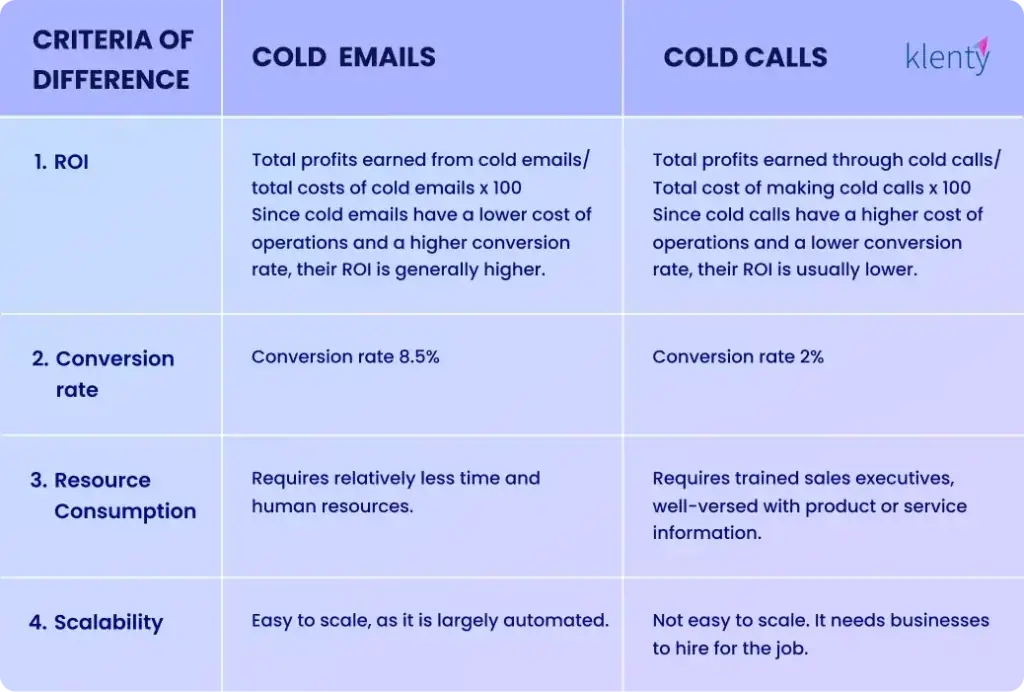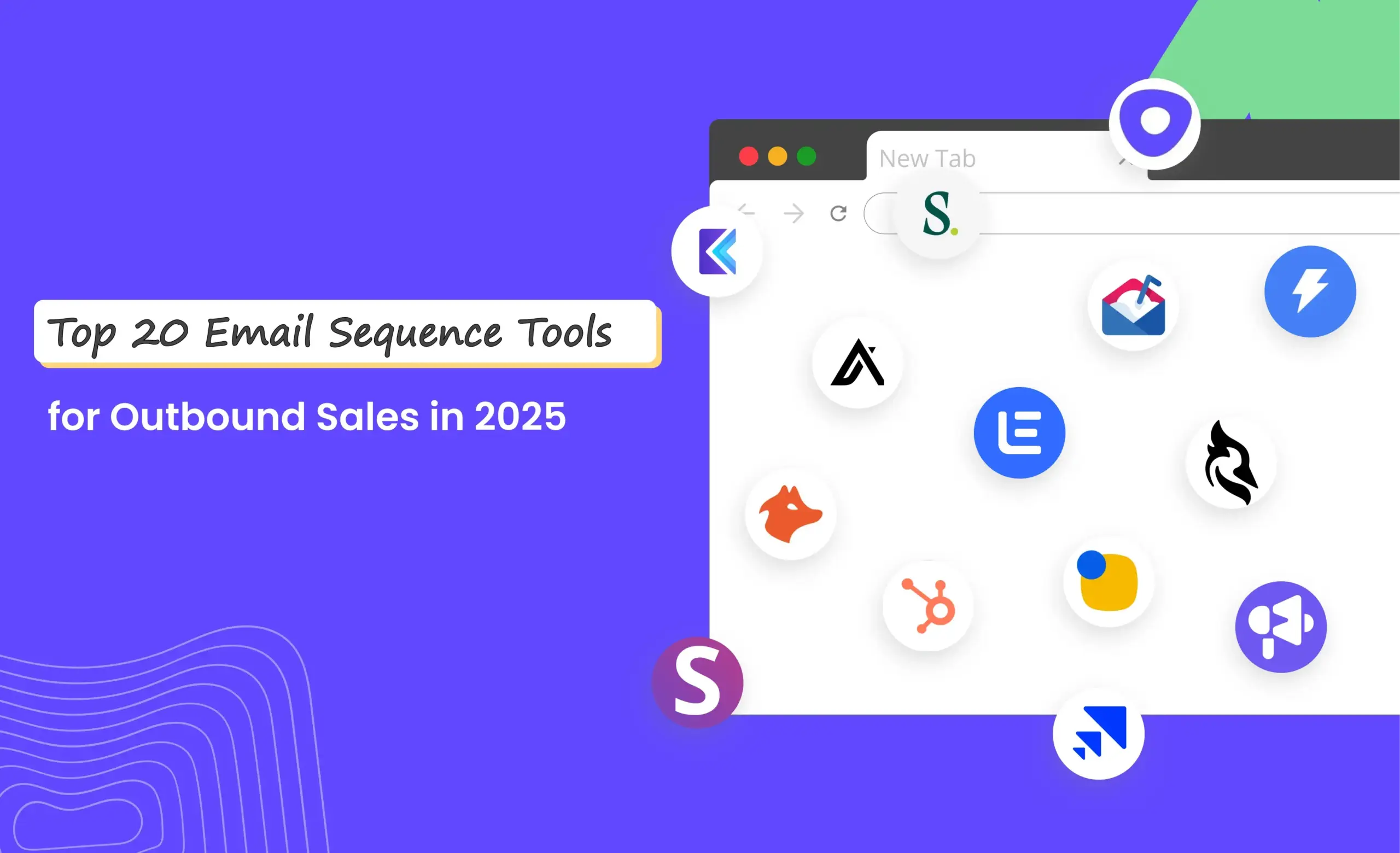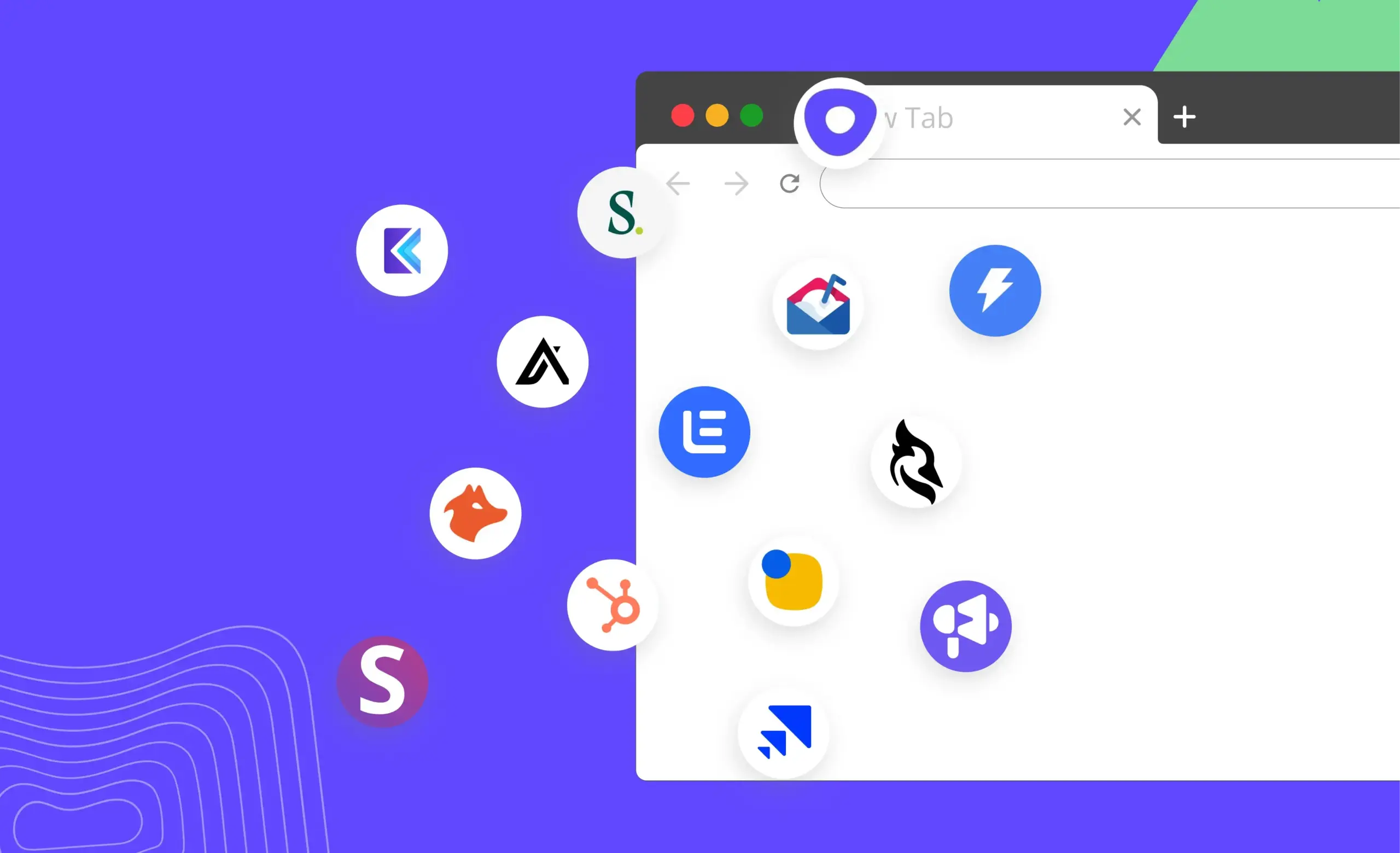Rumor has it a group of housewives started telemarketing in the 1950s to sell cookies to customers. Close to two decades later, Gary Thurek sent out the first cold email promoting a product for Digital Equipment Corporation. (That feat earned him the title the Father of Spam).
Cold calling and cold emailing have been around ever since. Technology has only made them easier. Plus, modern modes of communication haven’t come close to replacing them, given their ease of use and universality.
But as a salesperson (and one with quarterly goals at that) you can’t do everything, everywhere, all at once. You need to pick and choose.
Naturally, the question remains: Cold email vs. cold call—which holds up better?
Here, we’ll lay out the differences between cold emailing and cold calling, list the pros and cons, and finally tell you which sales outreach mode you should pick.
Cold Email vs. Cold Call
What Are Cold Emails?
Cold emailing is an outreach technique which involves sending emails to potential customers who haven’t yet shown an interest in your product or service. This unsolicited outreach method helps companies improve sales reach.
In the best of cases, cold emails help you begin a relationship with your customer, not just get their attention. Let’s take a scenario.
Consider yourself a door-to-door salesperson. You knock on a potential customer’s door. They don’t answer, so you leave a note personally addressed to them with your name, number, and the reason for your visit. That’s cold emailing. It allows customers to feel respected. And if they’re interested, they’ll get back.
Thinking about doing cold email outreach? Read our guide on how to write a cold email to get started.
What Are the Advantages of Cold Email Outreach?
Here’s a look at what cold emailing brings to the table.
1. Allows You To Meet the Customer Where They Are
The average professional checks their email every 37 minutes or 15 times daily. This makes a prospect’s inbox the perfect place to approach them.
As one product manager puts it, “Do not cold call me without an email first. Odds that I'll call you back are around 0% vs maybe 5% email back.”
But why?
Your prospects are busy. Interrupt them at the wrong time, and they will mentally cross off your company’s name.
Cold emails are less intrusive than other forms of outreach, given your prospect doesn’t need to respond to your outreach efforts instantly. If they want to, chances are they are intent on building a connection with you too.
2. Easy to Scale
Cold emails are easy to scale. If you adopt an email engagement tool, automating your sales outreach efforts would mean adjusting the scale of email operations with a single click. Growth gurus like Samuel Thompson swear by it (he sent 1.2 million emails through G Suite in 11 days).
P.S: We don’t recommend scaling your cold email efforts that much, especially if you have a low sender reputation and you’re doing outreach manually on the grounds that your email service provider (ESP) may mark you as spam. Instead, warm up your inbox and use tactics to boost engagement. Scale gradually when your sender reputation improves.
3. Low Operation Cost
One of the most significant benefits of cold emailing is that it doesn’t need much to work. With the internet and a device with an email service, you’ve got everything to start your cold email outreach.
Unlike cold calls, which require multiple sales development executives (SDRs) to make calls, cold emailing can work even if you give one talented SDR the right cold email tool. Then the overhead costs of salary, insurance etc., fall to near-zero.
What Are the Disadvantages of Cold Email Outreach?
1. High Competition
The above benefits aren’t lost on your competitors. You best believe your competition’s email awaits the seat next to you, hoping to be opened.
You must work twice as hard to get your email noticed enough to warrant a click. That brings us to our next pain point.
2. Personalizing Emails Is Hard
More so, when everyone in your prospect’s inbox personalizes the same way.
Gerry Praysman, Sr. Director of Commercial Growth at Salesloft, saw a flurry of emails with similarly personalized subject lines in his inbox one day and penned a strongly-worded LinkedIn post about it. Long story short, your prospects will recognize if you’re using a personalization template quickly.
What do you do then? Gerry Praysman urges SDRs to put in more effort. “That’s what people notice,” he adds. If you’re an SDR with an overflowing list of leads, we can hear you go, “but we don’t have that much time.”
Our tip: Don’t put in effort personalizing every email. Instead, personalize based on deal sizes. The lower the deal size, the lesser the personalization it needs.
Deal Size = Price of your plan($) x No. of Seats taken by a Prospect.
3. Can Take Time to Show Results
“I quit sending cold emails quite a while ago, the payoff relative to the amount of work was way too low,” wrote one salesperson on Reddit. Ask around, and many more will agree.
This isn’t surprising, given your email is landing in a pretty populated inbox. Even if your email tool detects an open, you can’t tell if they actually want to connect with you. And so, knowing whether your cold email did the trick can’t be ascertained quickly. Worst case, you could get stuck with a bloated pipeline for months.
Pro Tip: Follow up on your unanswered cold emails. Aleksandr Volodarsky, CEO of Lemon.io, suggests this method in a tweet: “Follow up every T+2, T+5, and T+7 days. You'll show you care and receive 40-50% more responses.”
A word of caution: Following up too often isn’t a good idea to subscribe to either. Especially if the prospect has responded with an unfortunate ‘not interested’. It can irritate them and lead to marking you as spam.
4. They Might Never Reach Your Prospects
The last downside of cold emails is not knowing whether they made it in front of your prospect. The average open rate for cold emails rests at 23.9%. This roughly translates to 12 emails opened for every 50 emails sent.
Further emails always run the risk of detouring to the spam folder. And this just means they never see the light of day.
Pro Tip: Run your sales emails through a tool like Litmus spam testing to ensure the Spam filter doesn’t pick them up. This way, your emails will more likely land in your prospect’s inbox rather than the junk folder.
What Are Cold Calls?
This outreach method involves sales reps making unsolicited phone calls to individuals to win their business.
Truth is people don’t want a phone call interrupting their day. And one from a salesperson pitching a that their business doesn’t need? Not in the least.
So, what kind of cold calls work? Ones that open up a conversation and convey the intent to be helpful. Belal Batrawy, Advisor at Salesfinity says his most successful cold calls “always got the prospect talking earlier in the conversation.”
If you’re in need of some inspiration, here’s a pro guide on how to cold call.
What Are the Advantages of Cold Calls?
1. Communicates Directly With The Prospect
Cold calling is like arriving at your prospect’s door with your message. Interruptive, yes. But if you make a good first impression, your prospect will most likely hear the end of it. Most times that is the start of a new relationship, best case, with a sale in sight.
We’d even stretch a limb and say cold calls work better especially if you’re reaching out to C-suite Executives. Sales coach Leslie Venetz says that it’s probably because most of them are over 50 years old and they used the telephone throughout their careers.
2. Instant Feedback
One of the top advantages of cold calling is that you can learn whether you’re on the right track fast enough. And if your calls are ending with a curt ‘not interested’, you can tweak the cold calling script.
Shalhevet Engleson, Social Media and Community Manager at Dealhub and member of Sales Enablement Collective, agrees with this sentiment. “(During a cold call) you also have a lot of flexibility to pivot and change your message when you come up against objections,” she adds.
What Are the Disadvantages of Cold Calls?
1. Cold Calling Has a Bad Rep
Over the years, poorly trained sales reps have earned cold calling a lousy reputation. So much so that in some parts of the world, people install software to block them (we know). Little surprise then that most SDRs don’t get past the ringer. And even those that do get a mere 30 seconds to make their case.
The key here is to become recognizable to your prospects even before you get on the call, according to Donald C Kelly, CEO of the Sales Evangelist. “When most people answer a phone call, in their head, they then try to put the caller in 1 of 2 camps… ‘someone I know’ or ‘someone I don't know’,” he concurs. His tip, find common ground for connection and open your cold call with it.
For instance, the opener ‘We both engaged on "ABC's posts about…’ could generate enough familiarity for prospects to stay on the call.
2. It is Time Consuming
The average cold calling success rate rests at 2%. This means that for every hundred calls, you can expect two to result in a meeting.
Now, if your average duration of a cold call is about 4 minutes and 50 seconds, you’re making about 100 calls on a given workday. And might we add, that’s without any break. The most you can automate here is data entry or dialing, which will save you a few minutes and help you squeeze in a dozen more calls.
Compare that to cold emailing, and you’ll quickly realize that you cannot realistically reach out to that many prospects, even on your best day. This leaves you with the only option of hiring someone for the job.
3. Tech Poses a Threat
Lastly, technologies like call blocking, spam filters, call ID, etc., seriously threaten cold calling efforts. Why? Because they use specific algorithms that measure the number of calls from a number, and the call duration, among other details, and mark caller IDs as spam.
As an SDR, you’re most likely focused on reaching out to many prospects and closing calls quickly, putting you at a high risk of being tagged as a spammer. So, forget about converting the prospect; you can’t even talk to them.
Cold Email vs. Cold Calls: Top Differences & When to Use It

When Should You Choose Cold Email?
1. When You Have a Small Sales Team
Cold email campaigns don’t require a large human resource, given one person can send cold emails at scale with sufficient training and access to cold emailing software. Further, in the case of small businesses, referrals, and cold emails offer a much more cost-effective alternative.
2. When You’re Pitching to Prospects from an ICP that Prefers Emails
People working at mid-market and enterprise-level companies prefer cold emails to cold calls, given the point of contact employees, gatekeepers, or assistants don’t like interruptions while working. Additionally, companies in retail, tech, business services, and marketing and advertising, among others, are more likely to respond to cold emails.
3. When You Have Limited Resources Available
Cold emails have a low overhead cost and don’t require using expensive tech to get started. This makes them ideal for small or growing companies.
4. When Your Business Goals Don’t Demand Instant Results
If your sales strategy is focused on building long-term connections with prospects, consider cold emailing. However, this approach takes longer to show results, given your prospects must choose to see your emails for your sales cadence.
That said, if your prospects show prolonged interest, it is usually a good indication that they are far down the sales pipeline and will convert into a potential customer. Moreover, knowing whether your cold email templates are working will take time.
Expert take:
Vengat Krishnaraj, co-founder and CEO of sales engagement platform Klenty, says email is great for capturing people who are well into the buying journey. “If I'm already looking for a service and you email me at the right time, I'll reply to you and I may take the call,” he notes.
The flip side is, given emails have become so ubiquitous, reply rates have nosedived. “People see the email, they may even read the email, but very few people reply to you unless they already have a strong pain point,” he explains.
When Should You Choose Cold Calling?
1. When You Have a Larger Sales Team
Cold calling requires salespeople to make sales calls. And since one person can’t have two conversations, and automating them takes away the human element, a substantial sales team is a must for cold calling. Of course, the size of your team will depend on your budget and goals.
2. When You’re Pitching to Prospects from an ICP that Prefers Calls
If you’re a company in the fintech, legal, business services, or education space, your prospects might more likely prefer cold calls to emails. Moreso, if they are small business owners, given they have the time to receive a call.
Additionally, research from RAIN group suggests that 57% of C-Suite and VP buyers across industries would much rather get on call. The reason is twofold. These prospects are more comfortable over the phone and less intimidated by sales calls.
3. When You Have a Higher Company Budget
Cold calling requires resources such as phones, SDRs, etc. And so, it becomes ideal for medium to large companies with a budget to accommodate these.
4. When Your Business Goals Demand Instant Results From Outreach
If your sales strategy involves quickly building a relationship with the prospect, consider cold calling. After all, this outreach method allows you to talk directly to the prospect and understand their jobs, pain points and goals, giving you insights into what they would value in a product. This could help you tailor your pitch and sell your product subsequently.
Expert take:
Compared to cold emails, Vengat Krishnaraj says cold calls can work for buyers who are on the fence. “Calling captures the lack of urgency. For on the fence people, people who may potentially buy, people who feel like, ‘I may need this, but my pain is not so much that I'm willing to book a time with you for a call.’ So it usually captures people with slightly lesser intent,” he explains.
When Can You Choose Both?
We’d say choose both if you have the resources for them. Why? Here’s what experts say.
1. You Don’t Know Which Channel Your Prospect Prefers
Every prospect is different, even if they belong to the same ICP. If one prefers talking, given they are more extroverted, another might prefer a cold email, given it is convenient. And as an SDR who doesn’t know your customer’s individual preferences, prioritizing one outreach effort over another is akin to leaving meat on the bone.
Dan Drucker, Vice President of National Sales and Marketing at Canon, subscribes to the use of all tools until you find one that works framework. Why? “(Because) you don't know what the person on the receiving end prefers,” he says.
Meanwhile, others like Maria Bross, Director of Sales Enablement at Revenue.io, believe in maximizing their chances of a response by focusing on reach. “Your voicemail directing your prospect to your subject line helps with opens. The email you sent prior to getting a prospect on the phone helps you get a few more seconds than you normally would have sans email,” she says.
2. Focus on the Message, not the Medium
Jen Allen-Knuth, who leads Community Growth at Lavender, believes SDRs harping on whether to reach out to prospects via cold call or cold emails are focusing on the wrong issue. To convert a prospect on any medium, they should be focusing on reaching out at the right time and starting a relevant conversation. “I stand for sellers being crystal clear on why they are reaching out to a buyer and why now,” she adds.
3. Play to Your Strengths
SDRs on the field however, share different opinions. Many agree that the best prospecting method in their experience is the one they have a natural flair for. As Scott puts it, “At the end of the day, it is a strategic choice. I am better at cold emailing than I am at cold calling. I'm not going to tell someone else that they need to solely focus on cold email. If you're great on the phone, go for it.”
Final Thoughts
Cold calling and cold emailing offer their share of merits and demerits. So, it ultimately comes down to what suits your sales process, target audience and business goals best. Choosing between the two means missing out on viable outreach opportunities.
As discussed above, sales teams can combine both to drive sales outreach. So, before you bring the gavel down, it's best to take a second look at your sales goals. Can you do without cold calling? Can you do without cold emailing? If you don’t have a definite answer to these two questions, it’s time to mix it up and build an outreach strategy with both.
Resources You'll Love
FAQs
Is Cold Calling Outdated?
Cold callers must take the time to build a relationship with the prospect rather than racing to make a pitch. They must learn their problems and gain their trust. Only after that can they hope to bring them on board. Go any other way, and you risk getting labeled and flagged as spammers.
How Do I Get Clients Without Cold Calling?
- Engage in Social Selling
SDRs can leverage platforms like LinkedIn to approach prospects. Salespeople can use LinkedIn’s messaging ad feature to run ads in their DMs.
- Try cold emailing
This sales technique allows your prospect to connect with you at their convenience. Personalize your emails like we discussed above and your chances of furthering the conversation improves even more.
- Upsell your product
If your prospect is on a free trial that is about to expire, you can reach out to them via a cold outreach. You can upsell your product, meaning offer your prospects a paid version of the tool in your outreach message.
- Offer incentives for referrals
Introduce a referral program with current customers. And use their connections to drive your outreach. After all, nothing gets the job done like word of mouth.





